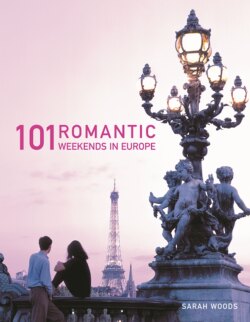Читать книгу 101 Romantic Weekends in Europe - Sarah Woods - Страница 27
На сайте Литреса книга снята с продажи.
021 NORMANDY
ОглавлениеCONTACT Claude Monet Foundation Tel: +33 2 32 51 28 21 Fax: +33 2 32 51 54 18 Email: contact@fondationmonet.com www.fondation-monet.com
To journey through Claude Monet’s dazzling, bloom-filled gardens at Giverny is to understand his passion for heart-stirringly vivid colour. For this living, growing, floral canvas boasts an extraordinary combination of hues: a trademark of this great initiator of the evocative Impressionist style of painting. Weeping willows trail over delicate wooden bridges set amidst a blaze of bold violet-blues tempered by green lilies and golden flecks. Soft cherry pinks, mellow mauves and inky purples morph into pewter shadows while crimson poppies tumble across the warm amber hayfields that surround the gardens. Depicting love and the natural world, Monet was inspired by the sensual splashes of colour that enveloped him, from the joyous sunshine of summer and autumn’s fallen leaves to the bleakness and wonderment of winter. Life, love and romance were his favourite themes. Like his oils, plants were Monet’s artistic tools of the trade with the bare soil in his gardens at Giverny his canvas. Mixing his colours became a love-fuelled obsession that transcended art: ‘More than anything else, I must have flowers, always, always...’, he wrote.
Monet’s adoration of colour is evident throughout his five-acre garden. Using vibrant shrubs for year-round colour and texture, he experimented with bulbs, perennials and annuals from all over the world. Monet loved the hazy, shimmering effect of colour and created numerous series of flower-stuffed geometric beds and rose-covered arches. By selecting plants that swayed and fluttered in the breeze, Monet created movement, evident in a rippling tide of Oriental poppies that punctuate a sea of cosmos. A sophisticated palette daubed with blue, pink, yellow, red, green and silver owed its beauty to bearded irises, daisies, gladioli, hollyhocks, pansies, black violas, nasturtiums, cleome, phlox, forget-me-nots, bluebells, wallflowers, pinks, sage and sunflowers. Only black had no place in his garden, or his art.
Monet’s brushwork shows determination and rigorous observation, much like that of Edouard Manet, whose work in the 1860s proved a guiding influence to Impressionists. As a means of capturing the delicate colours he so cherished, Monet crafted beautiful injections of light and contrast in his canvasses, conveying the subtle essence of nature in the style of truly romantic art. He also demonstrated pure luminosity in his 19th-century gardens, dividing the planted areas into a flower-filled Clos Normand garden and a Japaneseinspired water garden. Since Monet’s death in 1926, these gardens have been open to the public. Today over half a million visitors a years from all over the world pay homage to Monet’s irrepressible affection for love, life, nature – and colour.
A kaleidescope of colours at Monet’s gardens at Giverny.
